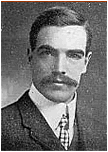
The town of Fernie was built on an economic base of coal mining and production. In Spalding’s day, coal was the primary thermal energy source used to run railroads, factory engines, and to heat homes. By providing jobs and resources, the coal industry in Fernie enabled the town to thrive economically, promoting business and population growth.
Spalding’s photographs of industry, both in Fernie and surrounding areas, depict the richness of nature’s resources and man’s ingenuity at extracting them. In his photograph of men loading coal into boxcars at Coal Creek Mines, for example, Spalding illustrates the vast complex of machinery needed to support the coal industry (fig. 0023). Another photograph of miners wearing rescue gear, however, reminds us of the mortality associated with this kind of work (fig. 0006). Men who went down in the mines performed a dangerous job, and frequent accidents claimed numerous lives. Those who escaped sudden death often died slowly from black lung, smothered by tiny particles of coal dust.
The glory of industry in Fernie is most keenly depicted in Spalding’s photographs of logging operations, where mountains of logs echo the mountainous horizon surrounding the town. A seemingly endless supply of trees often provides a backdrop to Spalding’s images of logging operations – no doubt he sought to promote Fernie’s bounty of natural resources. By 1924, the year Spalding left Fernie, the town had 15 sawmills in the surrounding area producing 180 000 000 board feet of lumber per year. Unlike many boom and bust towns that rose and fell before its incorporation, Fernie’s industrial base continued to thrive.

















